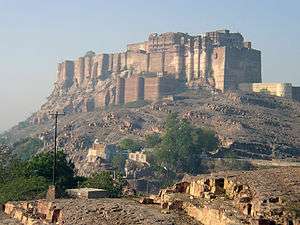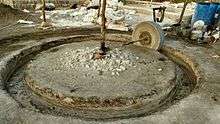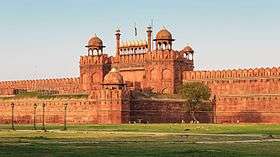Forts in India

The capital of each raja or chieftain was a fort around which a township grew and developed; this pattern can be seen in many South Asian cities such as Delhi, Agra, Rajasthan, Lahore, Pune, Kolkata, Surat and Mumbai. Two forts in India are UNESCO World Heritage sites: the Agra Fort and the Red Fort. The oldest surviving fort in India is the Qila Mubarak at Bathinda which had it origins in 100 AD during the Kushan empire. The Kangra Fort in Kangra believed to have been built by the still surviving Katoch dynasty after the battle of kurukshetra. The fort was written about by the scribes of Alexander the Great, thus making it the oldest fort in India.

Medieval Delhi developed around Chandni Chowk, the township adjoining the Red Fort while Kolkata came about Fort William built by the British. Many small towns ranging from Jhansi to Chandragiri grew around forts. Some towns even acquired the names from the forts. Durg is fort in Hindi. Satara was so named because of the seven forts that surround the Satara city.
The conquest of, or battles for the forts of India have been significant occasions in Indian history. The capture of Qila Mubarak (Bathinda) in 1004 AD by Mahmud of Ghazni heralded the advent of Islamic rule in India. The struggle of Shivaji against the Mughals in the seventeenth century and his reign occur against the backdrop of forts in the Deccan. There are more than 500 forts in Maharashtra. The importance of forts was at its peak during Maratha empire. The capture of Seringapatam and death of Tippu Sultan in 1799 cemented British rule in South India. The capture of Gawilghur by Arthur Wellesley, later Duke of Wellington, ended the Maratha threat to British rule in Central India at the time of the Second Anglo-Maratha War. After the demolition of Marathe empire, Britishers abandoned many forts and ruined them.
The flag of independent India was first unfurled from the ramparts of the Red Fort by Jawahar Lal Nehru, first Prime Minister of India on the morning of 15 August 1947. This practice of unfurling of flag followed by a speech by the prime minister continues each year on Independence Day. Just after World War II, the Red Fort had been the scene of the famous trial of the Indian National Army.
Etymology
Most of the forts in India are actually castles or fortresses. But when the British Government in India were cataloging them in the 17th–19th century they used the word forts as it was common in Britain then. All fortifications whether European or Indian were termed forts. Thereafter this became the common usage in India. In local languages the fort names are suffixed by local word for fort thus usage of the Sanskrit word durga, or Hindi word qila or the word garh or gad in Rajasthan, Assam and Maharashtra is common.[1] For example, Suvarnadurg, Mehrangarh, Sudhagad etc.
Forts in ancient India
Three major methods were used for the construction of ancient Indian forts. The first consisted of earthen ramparts. Often they were constructed of the sand which was dug out of the ditch surrounding the fort. The second of rubble with earth on the outside which was more sturdy. The third type of construction was with stone and masonry work. The last was the strongest. Often materials from demolished forts were reused in the building of new forts.[2]
By 4 BCE, fortified cities were common in India. The largest ones were between the city of Mathura (on the Yamuna river) and Magadha (on the Ganges). Another series of forts in the south, was on the Ujjain(on the Narmada) leading into the Deccan. These are inferred by the remains of fort walls and bastions seen on excavation at Rajagriha and at several sites in the Gangetic plain notably Kaushambi. At the latter site huge walls of burnt brick, which look like they have been battered. There does not seem to be any formal planning of these forts.[3]
There are few descriptions of these ancient structures. The most noted is the one by Megasthenes, an ambassador of Seleucus I Nicator to the court of Chandragupta Maurya. He describes Pataliputra as being guarded by a ditch with wooden walls. The fort had 570 towers and 54 gates with colonnaded halls decorated with gold and silver. One such hall has been excavated and is one of the oldest stone structures in India.[4]
Types of Ancient Indian Forts

Though most of the structures have been decayed and are lost, India's legacy of ancient forts is seen mostly in the shastras (ancient Indian treatises) and in the reliefs on stupas.[5] On some of the early relief work, the carvings indicate that ancient Indian forts has crenallations, embrasures and sloping walls.[3]
The Arthashastra the Indian treatise on military strategy describes six major types of forts differentiated by their major mode of defense:[6]
- Jala-durga (Water fort)
- Antardvipa-durga (island fortress): surrounded by natural (sea or river) water bodies. E.g. Murud-Janjira.
- Sthala-durga (plain fortress): surrounded by artificial moats or irrigated by a river.
- Dhanvana- or Maru-durga (Desert Fort): Surrounded by an arid area of at least 5 yojanas (73 km).
- Giri-durga (Hill fort)
- Prantara-durga: Located on a flat hill summit. E.g. medieval forts such as Chittor, Gwalior and Ranthambore.
- Giri-parshva-durga: The fortifications and civilian structures extend down to the hill slope (not just the summit).
- Guha-durga: Located in a valley surrounded by hills, where the outposts and the signal towers are located.
- Vana-durga (Forest fort): Surrounded by a dense forest over a distance of at least 4 kroshas (14.6 km).
- Khanjana-durga, built on a fen surrounded by thorny forests.
- Sthambha-durga, built in the forest among tall trees; lacks sufficient water sources.
- Mahi-durga (Earthen fort)
- Mrid-durga: surrounded by earthen walls
- Parigha-durga: Surrounded by earthen walls, as well as stone or brick walls. The walls are at least 5.4 m high and their width is half of their height.
- Panka-durga: Surrounded by fens or quicksand
- Nri-durga (Human fort)
- Defended by a large number of loyal and experienced warriors. Usually a city fortress, populated by a substantial garrison.
Each of these types had its own advantages and disadvantages. For example, according to the Manusmṛti, the forest fort suffers from monkey attacks, the earthen forts get swarmed with rodents, the water forts were plagued by diseases etc. The Manusmṛti considers the Hill fort to be the best defensive structure. Some Sanskrit text consider hill forts to be the abode of gods and hence auspicious. The Mahabharata describes the Human fort as the most effective fortification.[6]
Forts in Medieval India


With the advent of the Muslims, closely followed by the introduction of artillery in the 16th century there were several changes to the construction and design of forts. These changes were similar to the changes that took place in Western forts with the advent of gunpowder, i.e. the lowering of walls, thickening of walls, further pushing out of bastions etc.[7] The construction of a citadel in the centre and putting in more area between the citadel and the walls was characteristic of Muslim forts (influenced in turn by the Norman motte and bailey). Classic examples of such structures are the Golkonda and the Berar fort.[8]
The gates of medieval Indian forts were highly decorated.[9] Two distinct styles are seen. The Hindu style with a lintel and the Mughal style with an arch. Gates in Indian forts were often high and wide to allow elephants to pass.[10] Often they had rows of sharp, stout iron spikes to dissuade an attacking army from using elephants to break down the gates.[11] Such a gate with spikes can be seen on the Shaniwarwada fort, Pune. The walls of the forts were often looked higher from the outside than the inside as the forts made use of the natural rock formations on hills. This not only gave an illustion of greater height but also lead to the lower walls of the fort to be entirely made up of natural rock providing almost a perfect defense against the use of a battering ram or elephants to tear down the walls.[12] The main gate to the forts was located mostly facing north direction, this was to avoid its deterioration by the rains,winds and the sun.
Construction
Stone was the most important material for building fortifications in medieval India. Walls were erected by one of the following three construction methods. A wall could be an earthen rampart faced with stone on both sides. The rampart was built using the earth excavated while digging the ditch, with three-quarters of it used for building a rampart and one-quarter for levelling out the surface inside the fortress and in front of the ditch. Facing the rampart with stone allowed for the erection of higher and steeper walls than those possible with a purely earthen rampart. The structure had a substantial shortcoming, however: an earthen core accumulated water, which could destroy the stone shell. Drainage channels were therefore installed along the length of the wall from top to bottom. The main binding material for construction was Lime mortar.

The second method consisted of filling the space between the outer layers with earth mixed with rubble. This core was considerably harder than simply using rammed earth. The third and most advanced method involved the use of mortar. A rubble-built wall fastened with mortar was strong and long lasting. Construction methods depended, however, on the materials available.[2]
In medieval India, several reports exist of the practice of burying humans either dead or alive in the foundations of fort walls, to ensure their stability, being widely followed. It was believed that the ghosts of those sacrificed as such would keep evil spirits away. During the building of the Sri Qila, Delhi Alauddin Khilji is reported to have buried 8,000 skulls of Mughals killed by him into the foundation.[13] During the building of Purandar Fort one its bastions gave way several times. The king of Berar then ordered his minister an Esaji Naik Chive to bury a first-born son and his wife into the foundation of the bastion. This was promptly done and after a further offering of gold and bricks. When the bastion was finished Esaji Naik was given possession of the fort and the father of the sacrificed boy was rewarded with two villages.[13] Along with the fortification, emphasis was also given for construction of rock cut water cistern, ponds, wells and lakes. To avoid evaporation of water, the water bodies were covered. At times rooms were built close to water bodies to keep the temperature low.
Many Indian fortifications have parapets with peculiarly shaped merlons and complicated systems of loopholes, which differ substantially from similar structures in other countries. Typical Indian merlons were semicircular and pointed at the top, although they were sometimes fake: the parapet may be solid and the merlons shown in relief on the outside (as at Chittorgarh). What was unique is the arrangement and direction of loopholes. Loopholes were made both in the merlons themselves, and under the crenels. They could either look forward (to command distant approaches) or downward (to command the foot of the wall). Sometimes a merion was pierced with two or three loopholes, but more often, one loophole was divided into two or three slits by horizontal or vertical partitions.The shape of loopholes, as well as the shape of merlons, need not have been the same everywhere in the castle, as shown by Kumbhalgarh.[14]
Forts constructed by the British

With the advent of the East India Company, the British established trading posts along the coast. The need for security against local rajas as well as other European rival nations led to the construction of forts at each post. Mumbai fort, Fort William in Kolkata, Fort St George in Chennai were the main bastions constructed. These cities developed from the small townships outside the forts. Parsimony of the East India Company, non-availability of trained engineers and use of local materials and artisans resulted in the simple design and construction initially. The vulnerability of these earlier forts, hostilities with the French and the growing might of the Company resulted in stronger and more complex designs for the second round of construction, the design of Fort St George reflecting the influences of the French engineer Vauban.[15]
Current state
Although no Indian forts were destroyed by sudden disasters, there are several which were abandoned due to the ambitions of their rulers and have consequently deteriorated over time. Very few castles have survived unchanged since the early Middle Ages or even since the 14th-15th centuries: most of those built in the 10th-15th centuries were later rebuilt and altered. Castles were still used as living quarters until the 19th-20th centuries, and so were continually modified. Even now, some of them are private property.
See also
Notes
- ↑ Konstantin Nossov & Brain Delf 2006, p. 8.
- 1 2 Konstantin Nossov & Brain Delf 2006, p. 12.
- 1 2 Virginia Fass & Rita Sharma 1986, p. 13.
- ↑ Virginia Fass & Rita Sharma 1986, p. 14.
- ↑ Virginia Fass & Rita Sharma 1986, p. 11.
- 1 2 Konstantin Nossov & Brain Delf 2006, pp. 8-9.
- ↑ Virginia Fass & Rita Sharma 1986, p. 16.
- ↑ Virginia Fass & Rita Sharma 1986, p. 17.
- ↑ Sidney Toy 1965, p. 2.
- ↑ Konstantin Nossov & Brain Delf 2006, p. 15.
- ↑ Sidney Toy 1965, p. 1.
- ↑ Konstantin Nossov & Brain Delf 2006, pp. 15-16.
- 1 2 Sidney Toy 1965, p. 51.
- ↑ Konstantin Nossov & Brain Delf 2006, p. 27.
- ↑ Sandes, E.W.C. The Military Engineer in India, Vol I.
Bibliography
| Wikimedia Commons has media related to Forts in India. |
- Konstantin Nossov; Brain Delf (2006). Indian Castles 1206-1526 (Illustrated ed.). Osprey. ISBN 1-84603-065-X. Retrieved 27 March 2009.
- Sandes, E.W.C. (1934). The Military Engineer in India, Vol I. Institution of Royal Engineers, Chatham.
- Sidney Toy (1965). The Fortified Cities of India. London: Heinemann Educational.
- Virginia Fass; Rita Sharma (1986). The Forts of India. London: William Collins Sons. ISBN 0-00-217590-8.
- Yule, Paul (2007). Review of J. Deloche, Studies on Fortifications in India, Pondicherry. Asiatische Studien 63.2, 2009, 477–482. Zurich.
- Yule, Paul (2009). Early Forts in Eastern India, Antiquity vol 82 issue 316 June 2008, virtual Project Gallery. cambridge.
